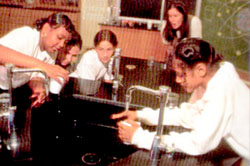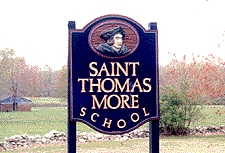|
● Going
to School in America Today
● Education—A Local Matter
● What
an American Student Learns
● Education
in a New Nation
● Learning
to Be World Citizens
● Higher Education
● Selecting
a College or University
● Trends in Degree Programs
● Education for All
Text
Going to School in America Today
 |
|
School Chidren
|
 Each
fall almost 50 million young Americans walk through the doorways
of about 100000 elementary
and secondary
schools for the start of a new school year. Filling classrooms from
kindergarten to the 12th grade, they attend classes for an average
of five hours a day, five days a week, until the beginning of the
following summer. These students are part of one of the most ambitious
undertakings
in the history of education: the American effort to educate an entire
national population. The
goal is—and has been since the early decades of the republic—to
achieve universal literacy
and
to provide individuals with the knowledge and skills necessary to
promote both their own individual welfare as well as that of the
general public. Though this goal has not yet been fully
achieved, it remains an ideal toward which the American educational
system is directed. The
progress which has been made is notable both for its scope
and
for the educational methods which have been developed in the process
of achieving it. Each
fall almost 50 million young Americans walk through the doorways
of about 100000 elementary
and secondary
schools for the start of a new school year. Filling classrooms from
kindergarten to the 12th grade, they attend classes for an average
of five hours a day, five days a week, until the beginning of the
following summer. These students are part of one of the most ambitious
undertakings
in the history of education: the American effort to educate an entire
national population. The
goal is—and has been since the early decades of the republic—to
achieve universal literacy
and
to provide individuals with the knowledge and skills necessary to
promote both their own individual welfare as well as that of the
general public. Though this goal has not yet been fully
achieved, it remains an ideal toward which the American educational
system is directed. The
progress which has been made is notable both for its scope
and
for the educational methods which have been developed in the process
of achieving it.
 |
|
A High School Lab
|
 About
85% of American students attend public
schools (schools supported by American taxpayers).
The other 15% attend private
schools, for which their families choose to pay special
attendance fees. Four out of five private schools in the United
States are run by churches, synagogues or other religious groups.
In such schools, religious teachings are a part of the curriculum,
which also includes the traditional academic courses of reading,
mathematics, history, geography and science.(Religious instruction
is not given in public schools.) About
85% of American students attend public
schools (schools supported by American taxpayers).
The other 15% attend private
schools, for which their families choose to pay special
attendance fees. Four out of five private schools in the United
States are run by churches, synagogues or other religious groups.
In such schools, religious teachings are a part of the curriculum,
which also includes the traditional academic courses of reading,
mathematics, history, geography and science.(Religious instruction
is not given in public schools.)
 |
 |
|
A Private School
|
A Church School
|
 The
combined expenses of both education systems, public and private,
exceed $190000 million a year. From that point of view, American
education is a powerful consumer. Who decides how many of these
thousands of millions of dollars should be used annually for teachers'
salaries, new computers or extra books? Private schools that meet
state standards use the fees they collect as they think best. But
where public taxes are involved, spending is guided by boards
of education (policy makers for schools) at the state
and/ or district level. The same thing is true for decisions about
the school curriculum, teacher standards and certification,
and the overall measurement of student progress. The
combined expenses of both education systems, public and private,
exceed $190000 million a year. From that point of view, American
education is a powerful consumer. Who decides how many of these
thousands of millions of dollars should be used annually for teachers'
salaries, new computers or extra books? Private schools that meet
state standards use the fees they collect as they think best. But
where public taxes are involved, spending is guided by boards
of education (policy makers for schools) at the state
and/ or district level. The same thing is true for decisions about
the school curriculum, teacher standards and certification,
and the overall measurement of student progress.
Previous Page Next
Page
|

